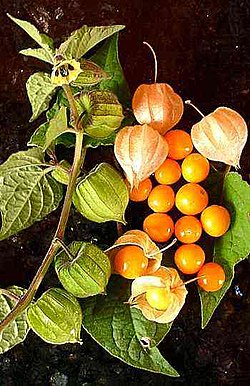Physalis peruviana
Species of cultivated South American fruit
| Physalis peruviana | |
|---|---|

Ripe orange fruits | |
| Physalis peruviana | |
| Scientific classification | |
| Kingdom | |
| Phylum | |
| Class | |
| Order | |
| Family | |
| Genus | Physalis |
| Species | peruviana |
| Binomial name | Physalis peruviana |
| Binomial authority | |
| Synonyms | Template:Species list |
Introduction[edit]
Physalis peruviana, also known as Cape gooseberry, goldenberry, and Peruvian groundcherry, is a plant species of the family Solanaceae, native to South America. It is a small shrub that produces edible fruit, which is used in a variety of culinary applications.
Description[edit]
Physalis peruviana is a small shrub that grows to a height of 1-2 meters. It has large, heart-shaped leaves that are dark green in color. The plant produces small, lantern-shaped flowers that are white with purple centers. The fruit of the plant is a small, orange-yellow berry that is encased in a papery husk.
Distribution[edit]
Physalis peruviana is native to the Andean regions of South America, but it is now cultivated in many parts of the world, including South Africa, Australia, New Zealand, and the United States. It is particularly well-suited to warm, tropical climates.
Cultivation[edit]
Physalis peruviana is usually grown from seed, which is sown directly into the soil in early spring. The plant prefers well-drained soil and plenty of sunlight. It is also important to keep the soil moist, but not waterlogged, during the growing season. The fruit is typically harvested when the husk turns brown and the fruit inside turns a bright orange color.
Uses[edit]
The fruit of Physalis peruviana is rich in vitamins A, C, and B-complex, as well as minerals such as iron and phosphorus. It is used in a variety of culinary applications, including as a topping for desserts, in jams and jellies, and as a flavoring in drinks.
In addition to its culinary uses, Physalis peruviana has a number of medicinal properties. It has been used to treat a variety of ailments, including stomachaches, fevers, and rheumatism. The fruit is also high in antioxidants, which can help to protect the body against damage from free radicals.
Cultural significance[edit]
In many parts of the world, Physalis peruviana is considered a delicacy. In South Africa, it is known as the "Cape gooseberry" and is used to make jams, jellies, and sauces. In Colombia, it is often used to make a dessert known as "queso con dulce," which consists of sweetened cheese and Physalis peruviana jam.
In traditional medicine, the plant is used to treat a variety of ailments. The fruit and leaves have been used to treat digestive disorders, fever, and inflammation. The plant has also been used to treat urinary tract infections, malaria, and cancer.
Gallery[edit]
-
Flower of Physalis peruviana
-
Fruit of Physalis peruviana
-
Tarte aux fruits with Physalis peruviana on top
See also[edit]
Physalis - the genus of the plant Physalis pruinosa - another species of Physalis Solanaceae - the family of flowering plants that includes Physalis

Annual of tropical South America having edible purple fruits
| This article is a stub. You can help WikiMD by registering to expand it. |
References[edit]
<references group="" responsive="1"></references>
External links[edit]
Ad. Transform your life with W8MD's Budget GLP-1 injections from $75


W8MD offers a medical weight loss program to lose weight in Philadelphia. Our physician-supervised medical weight loss provides:
- Weight loss injections in NYC (generic and brand names):
- Zepbound / Mounjaro, Wegovy / Ozempic, Saxenda
- Most insurances accepted or discounted self-pay rates. We will obtain insurance prior authorizations if needed.
- Generic GLP1 weight loss injections from $75 for the starting dose.
- Also offer prescription weight loss medications including Phentermine, Qsymia, Diethylpropion, Contrave etc.
NYC weight loss doctor appointmentsNYC weight loss doctor appointments
Start your NYC weight loss journey today at our NYC medical weight loss and Philadelphia medical weight loss clinics.
- Call 718-946-5500 to lose weight in NYC or for medical weight loss in Philadelphia 215-676-2334.
- Tags:NYC medical weight loss, Philadelphia lose weight Zepbound NYC, Budget GLP1 weight loss injections, Wegovy Philadelphia, Wegovy NYC, Philadelphia medical weight loss, Brookly weight loss and Wegovy NYC
|
WikiMD's Wellness Encyclopedia |
| Let Food Be Thy Medicine Medicine Thy Food - Hippocrates |
Medical Disclaimer: WikiMD is not a substitute for professional medical advice. The information on WikiMD is provided as an information resource only, may be incorrect, outdated or misleading, and is not to be used or relied on for any diagnostic or treatment purposes. Please consult your health care provider before making any healthcare decisions or for guidance about a specific medical condition. WikiMD expressly disclaims responsibility, and shall have no liability, for any damages, loss, injury, or liability whatsoever suffered as a result of your reliance on the information contained in this site. By visiting this site you agree to the foregoing terms and conditions, which may from time to time be changed or supplemented by WikiMD. If you do not agree to the foregoing terms and conditions, you should not enter or use this site. See full disclaimer.
Credits:Most images are courtesy of Wikimedia commons, and templates, categories Wikipedia, licensed under CC BY SA or similar.
Translate this page: - East Asian
中文,
日本,
한국어,
South Asian
हिन्दी,
தமிழ்,
తెలుగు,
Urdu,
ಕನ್ನಡ,
Southeast Asian
Indonesian,
Vietnamese,
Thai,
မြန်မာဘာသာ,
বাংলা
European
español,
Deutsch,
français,
Greek,
português do Brasil,
polski,
română,
русский,
Nederlands,
norsk,
svenska,
suomi,
Italian
Middle Eastern & African
عربى,
Turkish,
Persian,
Hebrew,
Afrikaans,
isiZulu,
Kiswahili,
Other
Bulgarian,
Hungarian,
Czech,
Swedish,
മലയാളം,
मराठी,
ਪੰਜਾਬੀ,
ગુજરાતી,
Portuguese,
Ukrainian


